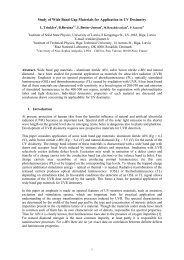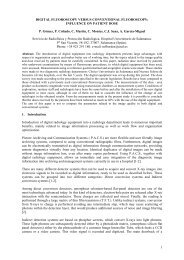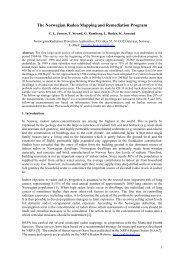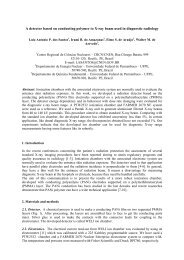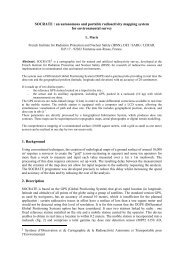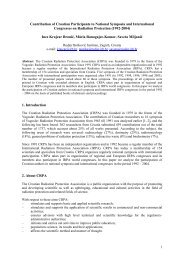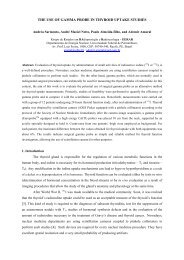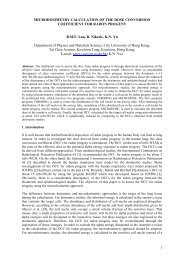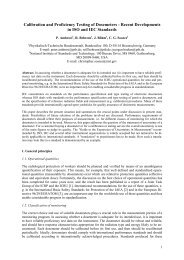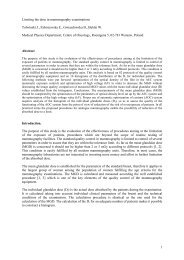irpa 11 guidelines for authors on the preparation of the full papers
irpa 11 guidelines for authors on the preparation of the full papers
irpa 11 guidelines for authors on the preparation of the full papers
You also want an ePaper? Increase the reach of your titles
YUMPU automatically turns print PDFs into web optimized ePapers that Google loves.
First, in order to acquire <strong>the</strong> characteristic <strong>of</strong> <strong>the</strong> glass dosimeter which equipping with a filter <strong>of</strong><br />
uni<str<strong>on</strong>g>for</str<strong>on</strong>g>m thickness, a basic model which covered <strong>the</strong> reading porti<strong>on</strong> <strong>of</strong> <strong>the</strong> glass element with a<br />
uni<str<strong>on</strong>g>for</str<strong>on</strong>g>m thickness filter <strong>of</strong> Sn in <strong>the</strong> range <strong>of</strong> 0-0.75 mm was created, and this model was included in<br />
<strong>the</strong> EGS4 code <str<strong>on</strong>g>for</str<strong>on</strong>g> per<str<strong>on</strong>g>for</str<strong>on</strong>g>ming a phot<strong>on</strong> irradiati<strong>on</strong> simulati<strong>on</strong>. Next, <strong>the</strong> simulati<strong>on</strong> which irradiates<br />
m<strong>on</strong>ochromatic phot<strong>on</strong>s in <strong>the</strong> range <strong>of</strong> 0.01-10 MeV to <strong>the</strong> model was carried out, and <strong>the</strong> amount <strong>of</strong><br />
energy absorpti<strong>on</strong> in <strong>the</strong> dose reading porti<strong>on</strong> <strong>of</strong> <strong>the</strong> glass element was calculated. The characteristic <strong>of</strong><br />
this model was obtained by breaking that absorpti<strong>on</strong> energy by <strong>the</strong> air Kama. This operati<strong>on</strong> was<br />
carried out to <strong>the</strong> o<strong>the</strong>r model to which <strong>the</strong> thickness <strong>of</strong> Sn filter was changed, and some different<br />
characteristic curves were collected. These characteristic curves were used <str<strong>on</strong>g>for</str<strong>on</strong>g> <strong>the</strong> development <strong>of</strong> a<br />
practical filter model which gives a new characteristic required <str<strong>on</strong>g>for</str<strong>on</strong>g> <strong>the</strong> measurement <strong>of</strong> an effective<br />
dose or a dose equivalent. The new characteristic was calculated by <strong>the</strong> method <strong>of</strong> weight averaging<br />
those characteristics with <strong>the</strong> suitable coefficients defined experientially. The coefficients were used<br />
<str<strong>on</strong>g>for</str<strong>on</strong>g> <strong>the</strong> design <strong>of</strong> <strong>the</strong> practical filter, and determined <strong>the</strong> area <strong>of</strong> each part <strong>of</strong> a filter which covers <strong>the</strong><br />
dose reading part <strong>of</strong> <strong>the</strong> glass element. The glass dosimeter equipped with <strong>the</strong> new designed filter was<br />
built into <strong>the</strong> EGS4 code, and it was examined whe<strong>the</strong>r <strong>the</strong> characteristic <strong>of</strong> <strong>the</strong> glass element shows<br />
<strong>the</strong> target characteristic.<br />
2.3. Acquisiti<strong>on</strong> <strong>of</strong> <strong>the</strong> basic characteristic data based <strong>on</strong> a simulati<strong>on</strong><br />
The glass dosimeter model which equipped with <strong>the</strong> filter <strong>of</strong> uni<str<strong>on</strong>g>for</str<strong>on</strong>g>m thickness as shown in <strong>the</strong><br />
following Figure 1 was created into <strong>the</strong> EGS4 code. Then, 100 milli<strong>on</strong> phot<strong>on</strong>s were equally irradiated<br />
from <strong>the</strong> 2 m away point <strong>of</strong> <strong>the</strong> model sides to <strong>the</strong> area <strong>of</strong> 3x3 cm 2 centering <strong>on</strong> <strong>the</strong> model, <strong>the</strong> energy<br />
absorpti<strong>on</strong> characteristic <strong>of</strong> <strong>the</strong> glass element was acquired <str<strong>on</strong>g>for</str<strong>on</strong>g> 42 kinds <strong>of</strong> phot<strong>on</strong> energy in <strong>the</strong> range<br />
<strong>of</strong> 0.01~10MeV. Moreover, nine kinds <strong>of</strong> thickness <strong>of</strong> a tin (Sn) filter was gradually changed with 0,<br />
0.1, 0.2,..., 0.7, and 0.75 mm, and <strong>the</strong> characteristic fi(x) (i=1to9) about each case was calculated,<br />
respectively. Where, x is phot<strong>on</strong> energy <strong>of</strong> a MeV unit.<br />
Sn<br />
Sn<br />
dose reading domain<br />
Sn<br />
hν hν<br />
Sn<br />
ABS<br />
ID No.<br />
glass element<br />
Fig.1.A compositi<strong>on</strong> figure <strong>of</strong> a basic model (<strong>the</strong> right is a short axis secti<strong>on</strong> and <strong>the</strong> left is a l<strong>on</strong>g axis<br />
secti<strong>on</strong>.), and phot<strong>on</strong> irradiati<strong>on</strong>.<br />
2.4. Compositi<strong>on</strong> <strong>of</strong> <strong>the</strong> characteristic corresp<strong>on</strong>ding to an effective dose or <strong>the</strong> dose equivalent<br />
The nine characteristics fi(x) (i=1 to 9) were multiplied by <strong>the</strong> coefficients ki and a new characteristic<br />
F(x) was compounded from those sums, as shown in following equati<strong>on</strong>.<br />
F(x)=k1f1(x)+k2f2(x)+ +k9f9(x) ---------- (1)<br />
where, k1, k2, , k9 were load coefficients which determined experientially and required <str<strong>on</strong>g>for</str<strong>on</strong>g><br />
obtaining <strong>the</strong> new characteristic suited to an effective dose or a dose equivalent. The sum total <strong>of</strong> ki<br />
2<br />
Sn



